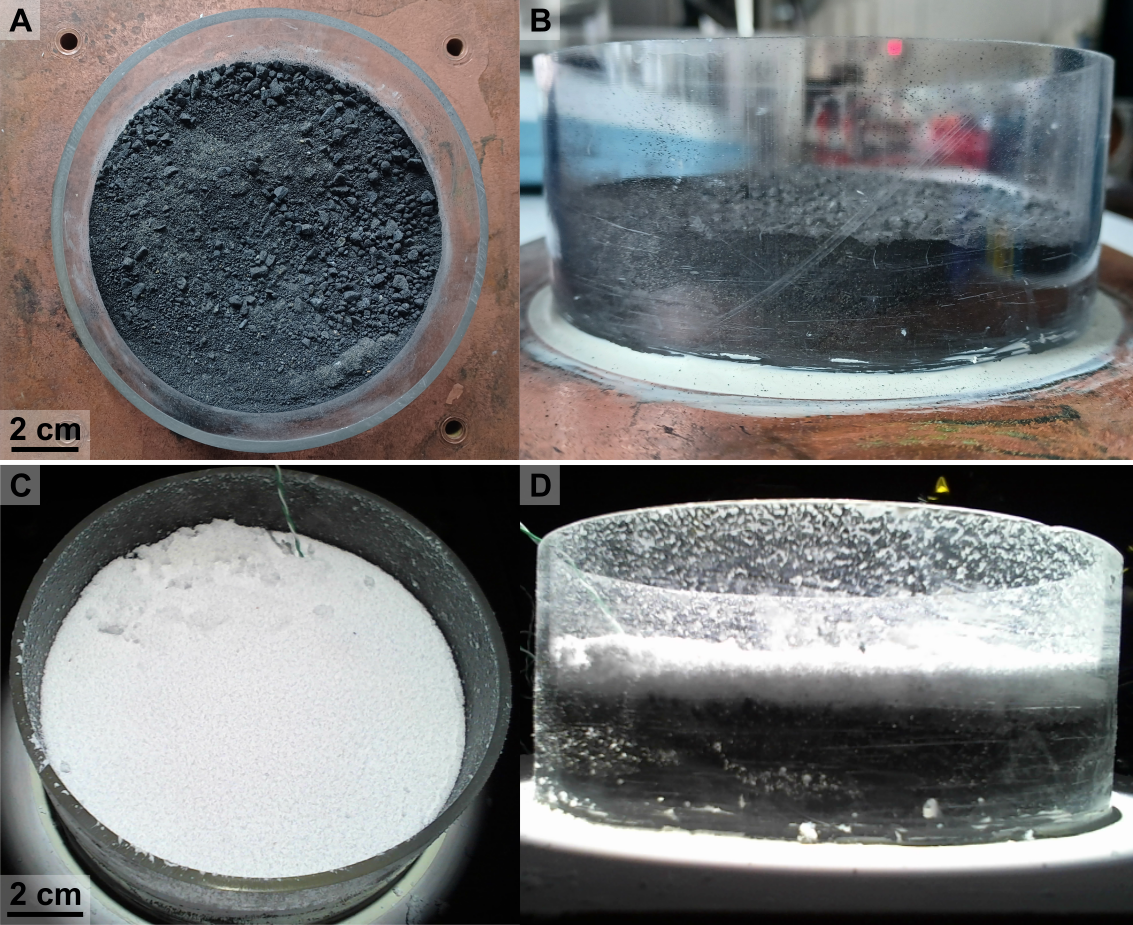Sublimation experiments to reproduce ammonium and chloride deposits under Cerean surface conditions
- Luleå University of Technology, Space Technology, Computer Science, Electrical and Space Engineering, Sweden (david.haack@associated.ltu.se)
Introduction
Sublimation experiments performed in vacuum chambers have proven helpful for understanding the processes that occur on the surfaces of volatile-rich celestial bodies without significant atmospheres [1, 2, 3]. In a multitude of celestial bodies where water ice is not found today, there are indications that it was present in the past. On dwarf planet Ceres, located in the asteroid belt between Mars and Jupiter, indicators of what might have been liquid water are significant. In addition to hydrated minerals, salt deposits have been detected at the surface [4, 5], which is difficult to explain without the presence of water. These deposits can be interpreted as remnants of former saline ice reservoirs or ascending brines and may substantially alter the physical properties of the Cerean regolith [6, 7]. It is still in debate how salt-rich ice was transported to the surface of Ceres. Cryovolcanism or hydrothermal processes near the surface may be possible processes [8, 9]. Plausible heat sources for melting near-surface ice could be decaying radionuclides in the interior of Ceres or heat generation from impact events during Ceres' history.
Methods
In a vacuum sublimation chamber, environmental conditions similar to those on the Cerean surface are reproduced, and the conditions under which brines can form salt crusts on a regolith analogue are investigated. The focus is on the parameters of salt composition and the scenarios of how salty ice and regolith analogue interacted in a low-temperature and low-pressure environment. In particular, Na+, NH4+, Cl-, and CO32- based salts were used since they are observed in specific areas of the Cerean surface. We use two salt mixtures with different ratios of the selected ions and prepare three experimental setups:
- The Ceres regolith analogue is placed in a transparent sample container, saturated with brine, precooled to a solid sample at 190 K, and mounted in a sublimation chamber.
- The regolith analogue is saturated with liquid brine and placed in the sample container without being precooled.
- The dry regolith analogue is covered with a layer of salty ice particles <500 µm and placed in the sublimation chamber.
The chamber's environmental conditions are adapted to Ceres and account for 200 K temperature, 5*10-5 mbar atmospheric pressure, and 180 Wm-2 irradiance. Each experiment lasts several days, during which the lateral and horizontal sample surfaces are permanently monitored with cameras (Fig. 1). After completing the sublimation experiments, the sample's surface and internal layer structure are analysed. To compare the spectral characteristics of Ceres' surface with those of the experiments, the reflectance spectra of each sample surface are measured in the spectral range of 400-2500 µm. We carry out two series of experiments with different salt compositions, tested for each of the three scenarios.
Outcome
We aim to test in laboratory experiments which scenario can reproduce salt deposits under environmental conditions similar to those of Ceres.
Possible scenarios how salts could be deposited are:
- Salty ice could have reached the surface of Ceres through cryoturbation and sublimated eventually, forming salt deposits.
- Brines may have originated from warmer depths of Ceres, where they ascended slowly to the surface, where the water sublimed, and the remaining salts formed crusts or efflorescences.
- Brines ascended beyond the surface eruptively, froze to salty ice particles, and fell back to the surface, forming salty crusts after the water sublimed.
 Fig. 1: Panels A, B show the top and side view of prepared Ceres analogue material in a transparent sample container with a diameter of 13 cm. Panels C, D present views of a sample in the sublimation chamber during the experiment. The scenario depicts a cover of salty ice particles that have fallen back onto the surface.
Fig. 1: Panels A, B show the top and side view of prepared Ceres analogue material in a transparent sample container with a diameter of 13 cm. Panels C, D present views of a sample in the sublimation chamber during the experiment. The scenario depicts a cover of salty ice particles that have fallen back onto the surface.
References
[1] Poch, O., et al. 2016, Icarus, 267, 154-173. doi:10.1016/j.icarus.2015.12.017
[2] Kaufmann, E., & Hagermann, A. 2018, Icarus, 311, 105-112. doi:10.1016/j.icarus.2018.03.025
[3] Haack, D., et al. 2021, Astronomy & Astrophysics, 649, A35. doi:10.1051/0004-6361/202140435
[4] De Sanctis, M.C., et al. 2020, Nature Astronomy, 4(8), 786-793. doi:10.1038/s41550-020-1138-8
[5] De Sanctis, M. C., et al. 2024, Communications Earth & Environment, 5(1), 131. doi:10.1038/s43247-024-01281-2
[6] Ruesch, O., et al. 2016, Science, 353(6303), aaf4286. doi:10.1126/science.aaf4286
[7] Fastelle, M., et al. 2022, Icarus, 382, 115055. doi:10.1016/j.icarus.2022.115055
[8] Raymond, C. A., et al. 2020, Nature Astronomy, 4, 741–747 doi:10.1038/s41550-020-1168-2
[9] Scully, J. E. C., et al. 2020, Nature Communications, 11, 3680. doi:10.1038/s41467-020-15973-8
How to cite: Haack, D., Kaufmann, E., and Hagermann, A.: Sublimation experiments to reproduce ammonium and chloride deposits under Cerean surface conditions, Europlanet Science Congress 2024, Berlin, Germany, 8–13 Sep 2024, EPSC2024-402, https://doi.org/10.5194/epsc2024-402, 2024.